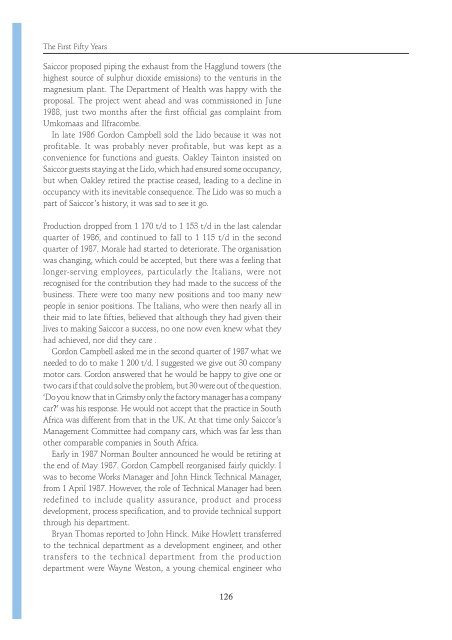You also want an ePaper? Increase the reach of your titles
YUMPU automatically turns print PDFs into web optimized ePapers that Google loves.
<strong>The</strong> <strong>First</strong> Fifty <strong>Years</strong><br />
<strong>Saiccor</strong> proposed piping the exhaust from the Hagglund towers (the<br />
highest source of sulphur dioxide emissions) to the venturis in the<br />
magnesium plant� <strong>The</strong> Department of Health was happy with the<br />
proposal� <strong>The</strong> project went ahead and was commissioned in June<br />
1988, just two months after the first official gas complaint from<br />
Umkomaas and Ilfracombe�<br />
In late 1986 Gordon Campbell sold the Lido because it was not<br />
profitable� It was probably never profitable, but was kept as a<br />
convenience for functions and guests� Oakley Tainton insisted on<br />
<strong>Saiccor</strong> guests staying at the Lido, which had ensured some occupancy,<br />
but when Oakley retired the practise ceased, leading to a decline in<br />
occupancy with its inevitable consequence� <strong>The</strong> Lido was so much a<br />
part of <strong>Saiccor</strong>’s history, it was sad to see it go�<br />
Production dropped from 1 170 t/d to 1 153 t/d in the last calendar<br />
quarter of 1986, and continued to fall to 1 115 t/d in the second<br />
quarter of 1987� Morale had started to deteriorate� <strong>The</strong> organisation<br />
was changing, which could be accepted, but there was a feeling that<br />
longer-serving employees, particularly the Italians, were not<br />
recognised for the contribution they had made to the success of the<br />
business� <strong>The</strong>re were too many new positions and too many new<br />
people in senior positions� <strong>The</strong> Italians, who were then nearly all in<br />
their mid to late fifties, believed that although they had given their<br />
lives to making <strong>Saiccor</strong> a success, no one now even knew what they<br />
had achieved, nor did they care �<br />
Gordon Campbell asked me in the second quarter of 1987 what we<br />
needed to do to make 1 200 t/d� I suggested we give out 30 company<br />
motor cars� Gordon answered that he would be happy to give one or<br />
two cars if that could solve the problem, but 30 were out of the question�<br />
‘Do you know that in Grimsby only the factory manager has a company<br />
car?’ was his response� He would not accept that the practice in South<br />
Africa was different from that in the UK� At that time only <strong>Saiccor</strong>’s<br />
Management Committee had company cars, which was far less than<br />
other comparable companies in South Africa�<br />
Early in 1987 Norman Boulter announced he would be retiring at<br />
the end of May 1987� Gordon Campbell reorganised fairly quickly� I<br />
was to become Works Manager and John Hinck Technical Manager,<br />
from 1 April 1987� However, the role of Technical Manager had been<br />
redefined to include quality assurance, product and process<br />
development, process specification, and to provide technical support<br />
through his department�<br />
Bryan Thomas reported to John Hinck� Mike Howlett transferred<br />
to the technical department as a development engineer, and other<br />
transfers to the technical department from the production<br />
department were Wayne Weston, a young chemical engineer who<br />
126

















